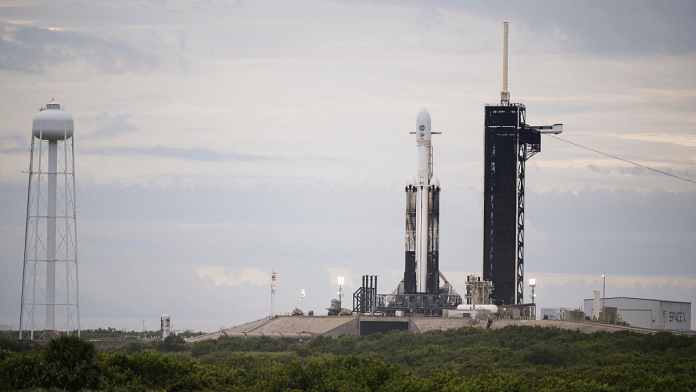Bengaluru: NASA is set to launch its Psyche mission Friday — a spacecraft that will for the first time explore a unique and mysterious asteroid with a core of nickel and iron.
The asteroid, also named Psyche, is located in the main asteroid belt between Mars and Jupiter and has a metallic core that is exposed to space — a rarity among asteroids. An understanding of this asteroid can give insight into the major and violent collisions that created both asteroids and Earth in the early days of the solar system.
The mission aims to uncover the secrets of this metallic world. It will determine if the asteroid is an independent entity or the leftover core from an early planet, and can help us learn more about the origin and evolution of planets, asteroids, and Earth.
The Psyche spacecraft, to be launched at 2.19 pm UTC (7.49 pm Indian Standard Time) Friday, will take about five years and 10 months to reach its destination.
It is expected to enter into orbit around the asteroid in August of 2029, and will remain there for 21 to 26 months — going around the asteroid and analysing it through its payloads/instruments. It will study the rock in four different orbits.
On the way to its destination, it will perform a gravity assistance manoeuvre with Mars in 2026 and use the planet’s gravity to speed itself forward. It is not expected to return any samples.
ThePrint explains what you need to know about NASA’s Psyche mission and what scientists hope to learn from it.
Also Read: Cosmic treasure! NASA’s asteroid sample that’s landed on Earth could hold clues to origin of life
Why Psyche?
The approximately 280 km x 230 km asteroid, known as 16 Psyche or simply Psyche, is not an ordinary one.
Unlike most asteroids, which are made of rock or ice, Psyche is mostly composed of metals such as iron and nickel, similar to the core of Earth and other terrestrial planets. This makes Psyche a rare and valuable object for scientific investigation, as it could provide insights into how planets form and differentiate (have a distinct core).
The mission is on a journey to study the exposed nickel-iron core of the asteroid. Such cores aren’t unheard of but aren’t found often in asteroids.
The asteroid belt between Mars and Jupiter contains enough material to come together to form a planet, but Jupiter’s gravity prevents this process from occurring.
However, in the past, some rocks did accrete into a larger mass that involved destructive collisions. The resulting impact would have made heavy elements settle towards gravity at the centre of the planet, with lighter elements on top — creating a core made of metal inside a big rock made of silicates and other rocky materials.
The presence of such a discernible core, which contains heavy metals different from the rest of the elements in the asteroid, indicates that the rock was differentiated and might have been on its way to forming a planet during the early days of the solar system.
It is believed that Psyche could be a leftover core from such a planetesimal — something that’s in the early stages of becoming a planet — which might have had a hardened shell that was destroyed in a collision, leaving behind the asteroid.
What do scientists hope to learn?
Studying the region of the asteroid with the exposed nickel-iron core would provide details about the time and process by which the differentiation occurred.
Understanding how asteroids formed gives clues into how the Earth was formed, although the latter would have occurred in warmer conditions as we are closer to the Sun. It also helps understand how other asteroids might have been formed and where they come from.
Additionally, understanding the composition of asteroids also helps grasp if and what role asteroids played in bringing water and organic molecules required for life to an uninhabited Earth in the ancient past.
Also Read: ‘No signals received,’ says ISRO as space agency tries to wake up moon mission’s lander, rover
What payloads does it carry?
The mission — the first to study a metallic body — carries a total of 30 kg of equipment, consisting of four instruments.
The multispectral imager will provide images at resolutions high enough to distinguish between metal and rock.
It is made up of two cameras that will image the same area with two different wavelengths — infrared and visible. This will enable understanding of surface features in 3D and also map the minerals present there.
The gamma ray and neutron spectrometer will determine the elemental composition of the asteroid by observing gamma rays from neutrons emitted when cosmic rays interact with the surface of Psyche.
The magnetometer will measure the low magnetic field around the asteroid and map it. Data about the strength of a past magnetic field would indicate whether Psyche was formed in a similar manner to Earth’s core — whose spinning liquid iron core creates a protective magnetic field around the planet.
The fourth is a gravity science instrument, which will use microwave and radio frequencies to study the interior of the asteroid by measuring gravitational anomalies.
(Edited by Richa Mishra)
Also Read: The UFO buzz is passe—NASA has a new term for it. Here’s why we’re still fascinated



